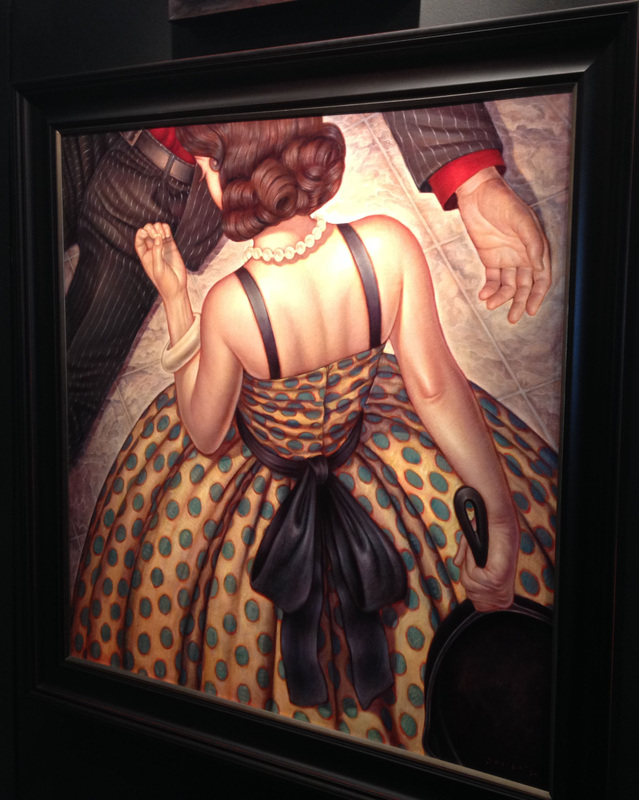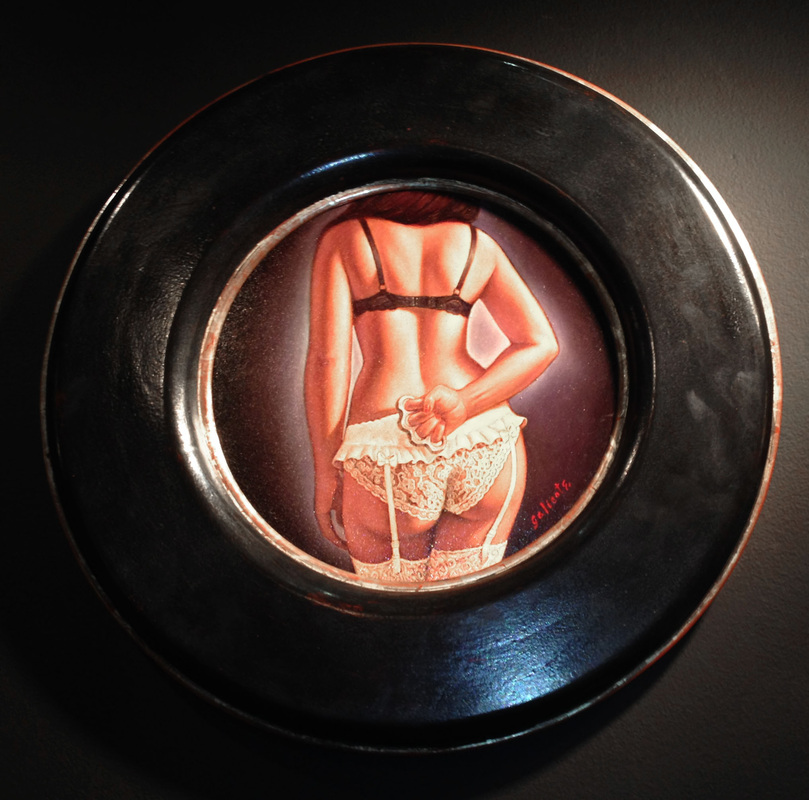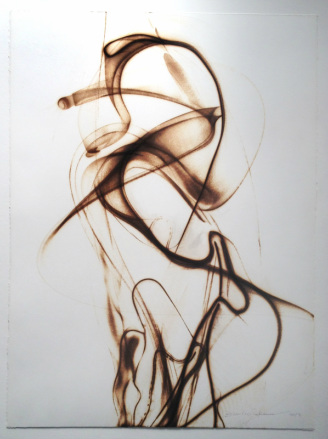ABC's new mini-series Killer Women, which is actually based on successful Argentine crime drama Mujeres Asesinas, highlights crimes committed by woman in difficult situations. But it's not the first artistic expression of women "behaving really badly." That honor goes to the 1926 play Chicago by Chicago Tribune reporter Maurine Dallas Watkins. She wrote about the real crimes that she covered! The focus of the play was corruption in the justice system and the ridiculous stardom that accompanied all the publicity the crimes received. A timeless subject, think Amanda Knox and Casey Anthony, the play was later converted into a Broadway musical and then the hit 2002 movie blockbuster starring Catherine Zeta-Jones and Renee Zellweger.
Here, artist Danny Galieote takes a stab at the theme with his sinister-magical realist works. Clearly inspired by the social realist/WPA movement of the 1930's and 40's, they scream retro. Reminiscent of works by Edward Hopper, Andrew Wyeth, and Paul Cadmus, Galieote's work is destined to join along side theirs. His hyper-detailed subject matter demonstrates Galieote's masterful technique and obvious talent. His use of unique compositional perspective, capturing the women at an angle from behind, strengthens the erotic sensation of his work. In Nighty, Night Dear, the slight upward, but direct angle achieves what every pornography cameraman knows - shooting up from below, makes the focal body part look bigger. In this case, her rump is magnified and becomes the voluptuous spotlight of the piece. In Shit, Chipped a Nail, again he captures the woman from behind, but from a downward diagonal, drawing our eye to the flawless skin of her bare back and shoulders and then the strand of pearls on her neck, always seductive parts of the female form. Of course, we are standing above and looking down on the murdered gent, owning the woman's power and superiority. And by filling most of the space with her petticoated, polka-dotted skirt, a seemingly unimportant characteristic, we focus on the her femininity contrasted against the cold, hard callousness of the iron skillet and her interest in her broken nail, not her murderous misdeed. In most of his recent works, by only showing us part of the subject and not letting us see faces, keeping the figures anonymous, Galieote makes us think more, titillating our imagination, which always excites.
But most importantly, Galieote's work perfectly captures the power of the feminine - the graceful stance of a woman in garters, hiding brass knuckles, the villainous housewife who has used the tools of her trade to betray her man yet is more concerned about getting a manicure than the consequences of her act. There's something erotic about a violent woman - especially when the violence is implied and not depicted. Galieote knows how to excite without being lewd. I say sophisticated and tantalizing!
These works were recently exhibited at the LA Art Show where these pictures were taken.
Here, artist Danny Galieote takes a stab at the theme with his sinister-magical realist works. Clearly inspired by the social realist/WPA movement of the 1930's and 40's, they scream retro. Reminiscent of works by Edward Hopper, Andrew Wyeth, and Paul Cadmus, Galieote's work is destined to join along side theirs. His hyper-detailed subject matter demonstrates Galieote's masterful technique and obvious talent. His use of unique compositional perspective, capturing the women at an angle from behind, strengthens the erotic sensation of his work. In Nighty, Night Dear, the slight upward, but direct angle achieves what every pornography cameraman knows - shooting up from below, makes the focal body part look bigger. In this case, her rump is magnified and becomes the voluptuous spotlight of the piece. In Shit, Chipped a Nail, again he captures the woman from behind, but from a downward diagonal, drawing our eye to the flawless skin of her bare back and shoulders and then the strand of pearls on her neck, always seductive parts of the female form. Of course, we are standing above and looking down on the murdered gent, owning the woman's power and superiority. And by filling most of the space with her petticoated, polka-dotted skirt, a seemingly unimportant characteristic, we focus on the her femininity contrasted against the cold, hard callousness of the iron skillet and her interest in her broken nail, not her murderous misdeed. In most of his recent works, by only showing us part of the subject and not letting us see faces, keeping the figures anonymous, Galieote makes us think more, titillating our imagination, which always excites.
But most importantly, Galieote's work perfectly captures the power of the feminine - the graceful stance of a woman in garters, hiding brass knuckles, the villainous housewife who has used the tools of her trade to betray her man yet is more concerned about getting a manicure than the consequences of her act. There's something erotic about a violent woman - especially when the violence is implied and not depicted. Galieote knows how to excite without being lewd. I say sophisticated and tantalizing!
These works were recently exhibited at the LA Art Show where these pictures were taken.



 RSS Feed
RSS Feed
